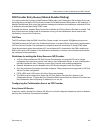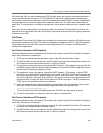
Entry Queues, Ad Hoc Conferences and SIP Factories
Polycom®, Inc. 283
IVR media files, WAV for voice messages and JPG for video slides, are stored on the application server. In
order to provide external IVR control, a TCP-based MCCF channel is created between the application
server and the media server. Because of real-time considerations, when the MCCF channel is established,
the application server notifies the media server about the media files. The media server downloads the
media files. The media server is notified by the application server when to download new or updated media
files.
When the call has completed the pre-conference phase in the external IVR-controlled Entry Queue, the
application server disconnects the call from the Entry Queue and routes the call to an ongoing conference
or creates a new VMR.
Call Flows
The external IVR-controlled Entry Queue can be initiated for various types of calls from SIP endpoints such
as standalone endpoints and Cisco TIP endpoints. Standalone endpoints are SIP or H.264 TIP endpoints.
These endpoints can include HDX systems, multiple Telepresence (ITP) screens, and RealPresence
Desktop client applications.
Call Flow for Standalone SIP Endpoints
The following describes how a standalone SIP endpoint call is placed into the IVR-controlled Entry Queue
and is then connected to a conference:
1 A SIP call is routed through the application server to the IVR-controlled Entry Queue.
2 The MCU answers the call and waits for the IVR media file requests from the application server. The
MCU does not control the call while the call is in the Entry Queue.
3 The application server may request, through the MCCF channel - IVR package, to play an audio file
and display a slide. When the audio file has finished playing, the MCU notifies the application server
that the audio file has been played for the call.
4 The application server may request, through the MCCF channel - IVR package, to collect DTMF
input such as a conference ID or password, from the caller. The DTMF input is transferred from the
MCU to the application server. When the application server receives the DTMF input, it validates the
input for the required conference ID or password. If the input is incorrect, the application server will
request the MCU to replay the audio file and collect the DTMF input again. The MCU transfers the
DTMF input to the application server for revalidation.
5 When the application server has completed the pre-conference IVR, the application server routes
the call to a VMR with the collected password appended to the following dial string:
<conf-id>**<password>@mcu-sig-ip.
The call is disconnected from the application server. The MCU now has control of the call.
6 The call is transferred to a conference, which can reside on another MCU.
Call Flow for Standalone TIP Endpoints
The following describes how a standalone TIP endpoint call is placed into the IVR-controlled Entry Queue
and is then connected to a conference:
1 A TIP call is routed through the application server to the IVR-controlled Entry Queue. TIP endpoints
can either have a single screen or multiple screens.
2 The MCU answers the call and waits for the IVR media file requests from the application server. The
MCU does not control the call while the call is in the Entry Queue.


















